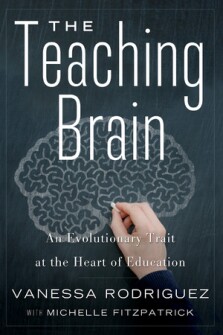Teachers are used to seeing studies about what a learner’s brain is like, but information about their own brains is far less common. Harvard researcher and veteran teacher Vanessa Rodriguez aims to change that in The Teaching Brain, a new book co-authored by Michelle Fitzpatrick that looks at teaching as an inherently human interaction rather than a one-way flow of information.
Rodriguez answered questions about her book in an interview with Education Week Teacher.
A New Definition of Teaching
Rodriguez says the book “started with a concept of defining what teaching is for human beings, which seems like a question we should have answered.” The premise of The Teaching Brain is that teaching is an inherent human trait, observable even in young children. Classroom teachers may have developed that characteristic more than other individuals, but everyone has the capacity to teach in some form.

This is one of the key takeaways from the book for Rodriguez. “The hope is that we’ll really just start to look at the word ‘teaching’ differently--that parents see themselves as teachers, businessmen see themselves as teachers, physicians see themselves as teachers.”
Moving Away From Student-Centered Learning
Rodriguez says that some of the strongest pushback to her ideas comes when she says that a student-centered approach might not be the best option.
Student-centered learning typically focuses on helping students take ownership of education through active participation in lessons, self-reflection, and critical engagement with material. It stands in contrast to more traditional teacher-centered, lecture-based approaches, which Rodriguez also criticizes as ineffectively portraying student minds as “empty vessels” waiting to be filled.
The problem with a student-centered approach, says Rodriguez, is that it only looks at part of the equation. “Teaching is automatically a human interaction,” she says. “It cannot happen in isolation. If teaching is inherently an interaction, then you can’t have anyone at the center. You need to understand the whole interaction, which is much more complex.”
“That kind of jars people, because who would want to say that students shouldn’t be at the center?” she says.
Rodriguez lays out five awarenesses that all great teachers should have: Awareness of Learner, Awareness of Interaction, Awareness of Self as Teacher, Awareness of Teaching Practice, and Awareness of Context. Right now, the focus in discussions about education tends to be on the first of these. However, Rodriguez says that when it comes to training new teachers, she “would propose the same amount of time we spend on the learning brain, we spend on the teaching brain.”
A teacher’s approach to the job and understanding of her students can drastically impact how she teaches. “I might think my job is to help create and form citizens and contribute that to a democratic society,” Rodriguez says. “That’s going to vastly shift the way I teach” compared to someone who sees their job as creating optimal test-takers.
She compares the teaching process to a chemistry experiment. “You need to understand [the chemicals] independently first in order to understand what’s going to happen when you put them together.” Conversations about teaching, then, need to recognize that both the teacher and the learner are active participants and work on understanding each participant individually.
A Changing Approach to Research
In an early article on the teaching brain, Rodriguez writes, “Too often researchers and policymakers use their findings to attempt to simply pour knowledge about learning into the teacher’s brain, as if those brains are ‘empty vessels.’ These efforts assume that to understand learning is to understand teaching. This is a grave mistake.”
Part of the problem with most current research, says Rodriguez, is that it’s done by researchers who often have no classroom experience. As a result, they tend to put forth “solutions” that aren’t practical to apply in real life. That’s why she advocates for hybrid roles where expert teachers can take time away from the classroom to do research.
Rodriguez also blames these impractical solutions on a desire for “quick fixes.” “The difference with teaching is it’s so unbelievably complex that there isn’t a quick fix,” she says, but after years of work, it can be hard for researchers to admit that they don’t have a simple answer to a problem.
Rodriguez intends her research to be a foundation for future work and hopes the book will “open the floodgates for having conversations ... about teaching within a very different paradigm than we currently do it.” From there, she sees potential for new research, changes in the way teachers are trained and evaluated, and more, saying, “I see The Teaching Brain as really just a start.”
Image courtesy of The New Press.